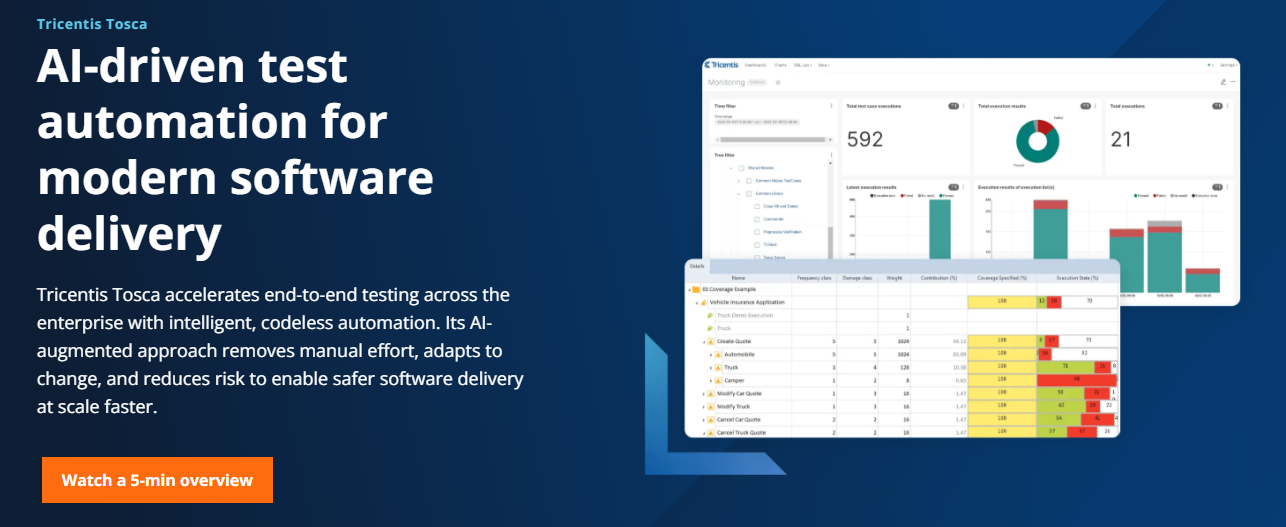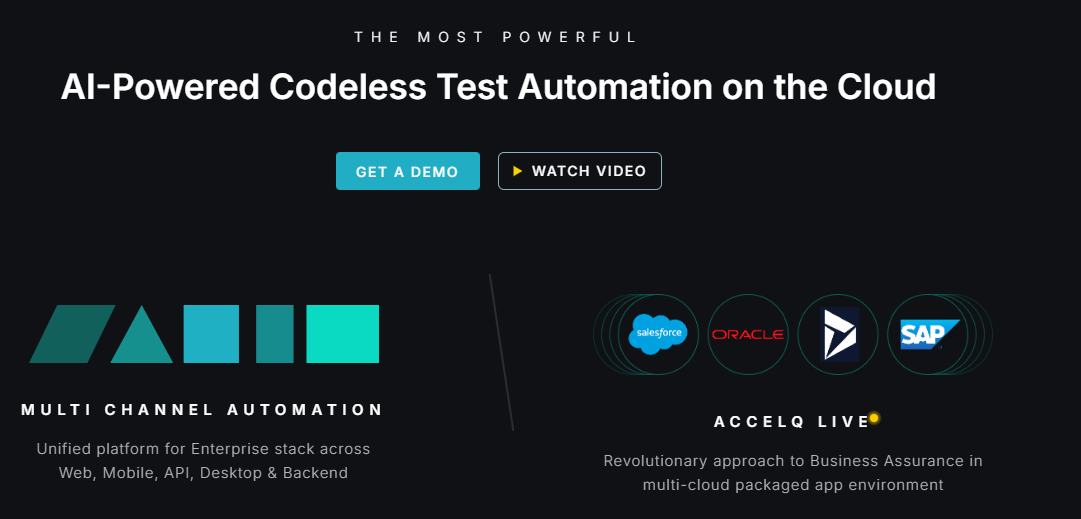The landscape of software testing is evolving rapidly, driven by the power of AI and low-code platforms. Tools like DevAssure have set a high bar for end-to-end test automation.
However, the market is rich with powerful DevAssure alternatives that offer unique strengths in areas like performance, platform support, and AI-driven self-healing.
This comprehensive guide explores ten of the best tools that can serve as a robust DevAssure alternatives, helping your engineering team find the perfect fit for their specific needs.
The Core of Modern Test Automation
Modern test automation platforms are defined by their ability to simplify complex tasks. They aim to reduce the time spent on test creation and maintenance, which are traditionally the biggest bottlenecks. This shift is primarily powered by AI and a move towards codeless or low-code interfaces.
These tools must offer seamless integration across the entire DevOps pipeline. They need to support continuous testing, ensuring that quality checks are an integral part of every development cycle. A strong DevAssure alternative must excel in speed, reliability, and ease of use for both QA and development teams.
Understanding the Need for DevAssure Alternatives
While DevAssure is a strong contender, no single tool is perfect for every organization. Teams often look for DevAssure alternatives due to specific requirements. These can include better support for niche technologies or a different pricing model that aligns with their budget.
Scalability is another major factor, as some tools handle massive test suites more efficiently than others. Furthermore, the level of AI sophistication, particularly in self-healing and test generation, can vary significantly between platforms. Finding the right balance of features is key.
Top 10 AI-Driven Testing Platforms
This section details ten of the most compelling DevAssure alternatives available today. Each platform brings a distinct set of capabilities to the table, catering to different testing philosophies and technical environments.
1. Panto AI

Panto AI is quickly establishing itself as a leader in the next wave of intelligent test automation. It’s end-to-end vibe debugging platform create and maintain test cases with minimal human intervention. This approach dramatically accelerates the initial setup time for new projects.
The platform boasts a unique natural language processing (NLP) engine. This allows users to describe the desired test scenario in plain English, and Panto AI generates the executable test script. This feature democratizes test creation, making it accessible to non-technical stakeholders.
Key Features of Panto AI
- Generative Test Creation: Automatically drafts test cases from simple text descriptions.
- Self-Healing Locators: AI dynamically adjusts element locators to prevent test breakage.
- Cross-Browser Execution: Supports parallel testing across a wide array of browsers and devices.
- API and UI Testing: Provides a unified platform for both front-end and back-end validation.
Panto AI is particularly well-suited for fast-moving agile teams. Its focus on low-maintenance testing ensures that the QA team can keep pace with rapid development cycles.
2. Mabl

Mabl is a well-known, dedicated AI QA test automation platform. It emphasizes ease of use and the power of machine learning for reliable, resilient testing. Mabl’s auto-healing capabilities are among the most mature in the industry.
The platform trains a model on your application’s UI over time. This allows it to automatically update tests when elements change, significantly reducing maintenance overhead. Mabl is a cloud-native solution, offering high scalability and zero infrastructure setup.
Mabl’s Core Strengths
- Unified Testing: Supports web, API, and mobile web testing from a single interface.
- Auto-Healing: Uses reinforcement learning to adapt tests to application changes.
- SaaS Model: Fully managed cloud service for effortless scaling and deployment.
- Deployment Integration: Deep integrations with CI/CD tools like Jenkins and GitHub Actions.
Mabl is often chosen by enterprises that prioritize stability and low-maintenance automation. Its comprehensive reporting includes detailed root cause analysis for quick debugging.
3. Testim

Testim, now part of Tricentis, offers a powerful, flexible solution for test automation. It combines a low-code visual editor with the ability to inject custom JavaScript code. This hybrid approach appeals to both citizen testers and seasoned automation engineers.
Testim’s core innovation lies in its smart locators, which use multiple attributes and AI-powered testing to identify elements. This makes tests highly stable and less prone to failure from minor UI tweaks. It is particularly strong in handling complex, dynamic web applications.
Why Choose Testim?
- Hybrid Approach: Low-code recording with full code customization via JavaScript.
- AI-Powered Stability: Advanced smart locators for robust test execution.
- Parallel Execution: Speeds up testing cycles by running tests concurrently in the cloud.
- Branching and Merging: Excellent support for managing tests within a version control system.
The platform is designed for teams that need both speed and technical depth. Testim provides detailed visual feedback on test runs, simplifying the debugging process.
4. Katalon Studio

Katalon Studio is a comprehensive, all-in-one automation testing solution. It supports a vast range of platforms, including web, API, mobile, and desktop applications. Its robust feature set makes it a strong competitor for teams with diverse testing needs.
Katalon provides a dual-scripting interface, allowing users to create tests using a record-and-playback feature or by writing code in Groovy or Java. This flexibility ensures that it can be adopted by teams of varying skill levels. The alternative is built on top of popular open-source frameworks like Selenium and Appium.
Katalon’s Versatility
- Multi-Platform Support: Covers web, mobile (iOS/Android), API, and desktop testing.
- Dual-Scripting: Supports both codeless and code-based test creation.
- Built-in Keywords: A rich library of pre-defined actions for quick test development.
- TestOps Integration: Seamlessly integrates with Katalon TestOps for test management and reporting.
Katalon is a highly versatile tool, often favored by organizations consolidating their testing efforts onto a single platform. Its community support is extensive, and its pricing model is flexible, offering options for small teams up to large enterprises.
5. TestRigor

TestRigor takes the concept of codeless testing to an extreme by focusing on pure English commands. Users write test steps in simple, human-readable language, eliminating the need to interact with element locators entirely. This approach makes test creation incredibly fast.
The platform’s AI engine interprets these English commands and translates them into executable actions. This dramatically reduces the learning curve and allows product managers or business analysts to contribute directly to the testing process. TestRigor is known for its exceptional stability.
Why TestRigor Excels
- Plain English Scripting: Tests are written using natural language, not code.
- Locator-Free Maintenance: Eliminates test maintenance related to UI changes.
- End-to-End Coverage: Excellent for complex, multi-step user journeys across different systems.
- Speed of Creation: Claims to create and maintain tests up to 15 times faster than traditional methods.
TestRigor is the ideal choice for teams struggling with high test maintenance costs. Its unique approach ensures that tests remain relevant and stable even as the application undergoes significant changes.
6. Cypress

Cypress is a fast, modern, and developer-friendly end-to-end testing framework. Unlike many other tools, Cypress runs directly in the browser, providing native access to the application under test. This architecture results in faster, more reliable test execution.
While it is a code-based framework (using JavaScript), its design philosophy focuses on a superior developer experience. It offers real-time reloads, automatic waiting, and a powerful, interactive test runner. Cypress is deeply integrated into the modern JavaScript ecosystem.
Cypress’s Developer Focus
- Modern Architecture: Runs tests directly in the browser for speed and reliability.
- Developer Experience: Excellent debugging tools, automatic waiting, and clear error messages.
- JavaScript Ecosystem: Uses familiar tools and languages for front-end developers.
- Component Testing: Offers robust support for testing individual UI components alongside E2E flows.
Cypress is best suited for development teams that own their testing and prefer a code-centric, highly customizable solution. It provides a level of control and speed that is often unmatched by low-code alternatives.
7. Playwright

Developed by Microsoft, Playwright is another powerful, open-source framework for reliable end-to-end testing. It is designed to overcome the limitations of older frameworks by supporting all modern rendering engines, including Chromium, Firefox, and WebKit.
Playwright’s key strength is its multi-browser, multi-language, and multi-platform support. It allows testing across different operating systems and in multiple programming languages, including Python, Java, and C#. Its auto-wait and retry mechanisms ensure high test stability.
Playwright’s Technical Edge
- True Cross-Browser: Supports all major browsers, including mobile emulation.
- Multi-Language API: Available in Python, Java, C#, and TypeScript/JavaScript.
- Parallel Execution: Built-in capabilities for running tests concurrently for speed.
- Test Generation: Includes a powerful Codegen tool to generate tests by recording user actions.
Playwright is the choice for technical teams that require maximum browser coverage and performance. Its modern design and active development community make it a future-proof option for complex web application testing.
8. Tricentis Tosca

Tricentis Tosca is an enterprise-grade, model-based test automation suite. It is known for its robust, comprehensive approach to quality assurance, extending far beyond simple UI automation. Tosca is particularly strong in managing large, complex application landscapes.
Its model-based approach means that a single test asset can be reused across different technologies and interfaces. This drastically reduces the effort required for test maintenance and updates. Tosca is often deployed in highly regulated industries and large-scale IT environments.
Tosca’s Enterprise Focus
- Model-Based Testing: Creates reusable test assets independent of the underlying technology.
- Risk-Based Testing: Prioritizes test cases based on business risk for maximum coverage.
- API and Performance: Comprehensive support for non-UI testing, including performance and load.
- Wide Technology Support: Excellent coverage for SAP, Salesforce, and other enterprise applications.
Tosca is a premium solution aimed at large organizations that need a centralized, highly governed, and scalable testing platform. Its strength lies in its ability to manage complexity and integrate quality across the entire enterprise portfolio.
9. ACCELQ

ACCELQ is a on-premise, AI-powered codeless test automation platform. It distinguishes itself with a strong focus on aligning debugging with business processes. The platform uses a unique concept of “Action Logic” to build reusable components.
This design philosophy ensures that tests are highly readable and maintainable. ACCELQ provides end-to-end automation for web, API, and mobile, all within a single, unified environment. Its self-healing capabilities contribute to a significant reduction in test maintenance time.
ACCELQ’s Unique Selling Points
- Codeless and Cloud-Based: Zero setup and no coding required for test creation.
- Action Logic: Reusable, modular components that map directly to business functions.
- In-Sprint Automation: Designed to keep pace with agile development and continuous delivery.
- Automated Test Generation: Can automatically generate test scenarios based on application models.
ACCELQ is an excellent alternative for teams that want to adopt a truly codeless, cloud-native approach. Its emphasis on business-readable debugging makes collaboration between QA, development, and business teams much smoother.
10. Leapwork

Leapwork offers a powerful, visual, and entirely no-code QA platform. It uses a flow-chart-based interface where users drag and drop building blocks to create automation flows. This visual approach eliminates the need for any scripting or coding knowledge.
The platform supports a wide range of technologies, including web, desktop, virtual machines, and SAP. Its enterprise-grade features include robust reporting, centralized control, and strong security. Leapwork is designed for business users and citizen developers.
Leapwork’s Visual Power
- Visual Flowchart Designer: Intuitive drag-and-drop interface for test creation.
- No-Code Automation: Absolutely no scripting required, making it accessible to all users.
- Broad Platform Support: Automates debugging across web, desktop, and complex enterprise systems.
- Centralized Management: Provides a single dashboard for managing all automation assets.
Leapwork is the perfect solution for organizations that need to empower non-technical users to build and maintain complex automation. Its visual nature makes it easy to understand and audit the automation flows.
Choosing Your Next Automation Partner
Selecting the right test automation tool is a strategic decision that impacts the entire software development lifecycle. The best DevAssure alternative depends entirely on your team’s specific context. Consider factors like the technical skill of your QA team and the complexity of your application.
If your priority is pure speed and AI-driven maintenance, a tool like Panto AI or TestRigor might be the best fit. For enterprise-level complexity and broad platform support, Tricentis Tosca or Katalon Studio are strong contenders.
Key Evaluation Criteria
When comparing these powerful DevAssure alternatives, focus on the following critical areas:
- AI Capabilities: Look for advanced self-healing, test generation, and intelligent reporting.
- Usability: Assess the learning curve for both technical and non-technical users.
- Platform Coverage: Ensure the tool supports all your required environments (web, mobile, API, desktop).
- Integration: Verify seamless connectivity with your existing CI/CD pipeline and test management tools.
- Scalability: Confirm the platform can handle your projected growth in test volume and complexity.
A successful transition to a new tool requires more than just feature parity. It demands a platform that aligns with your team’s workflow, team’s testing metrics, and long-term quality goals. The right choice will transform your testing from a bottleneck into an accelerator for high-quality software delivery.
Comparison of DevAssure Alternatives
The table below provides a quick, high-level comparison of the ten DevAssure alternatives discussed. This summary highlights their primary focus, core automation approach, and ideal user profile.
| DevAssure alternatives | Primary Focus | Automation Approach | Ideal User Profile |
|---|---|---|---|
| Panto AI | generative AI & NLP | Low-Code/NLP | Agile teams prioritizing speed and low maintenance. |
| Mabl | AI-Driven auto-healing | Low-Code/SaaS | Enterprises needing high stability and cloud-native ease. |
| Testim | Hybrid Flexibility | Low-Code + Code | Teams needing both speed and technical customization. |
| Katalon Studio | All-in-One Versatility | Codeless + Code | Teams with diverse testing needs across multiple platforms. |
| TestRigor | Pure English Scripting | No-Code/NLP | business users and teams focused on ultra-low maintenance. |
| Cypress | developer experience | Code-Based (JavaScript) | Development teams owning E2E testing in the JS ecosystem. |
| Playwright | Technical Performance | Code-Based (Multi-Lang) | Technical teams needing maximum browser coverage and speed. |
| Tricentis Tosca | Enterprise-Grade QA | Model-Based | Large organizations with complex, regulated IT landscapes. |
| ACCELQ | Business Process Alignment | Codeless/Cloud | Teams focused on business-readable, modular test assets. |
| Leapwork | Visual Automation | No-Code/Visual | citizen developers and non-technical automation specialists. |
This comparison should serve as a starting point for your evaluation process. Each of these platforms represents a powerful step forward in the world of AI-powered test automation. Choosing the right DevAssure alternative will empower your team to deliver faster, more reliable software.






